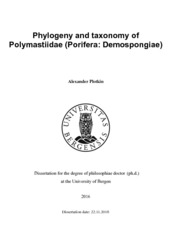| dc.contributor.author | Plotkin, Alexander | |
| dc.date.accessioned | 2016-12-02T08:03:43Z | |
| dc.date.available | 2016-12-02T08:03:43Z | |
| dc.date.issued | 2016-11-22 | |
| dc.identifier.uri | https://hdl.handle.net/1956/15225 | |
| dc.description.abstract | This thesis focuses on the family Polymastiidae, one of the key taxa of sponges (phylum Porifera), an important component of marine benthos in the polar and temperate seas. The current taxonomy of this family is based on rather few unstable morphological characters. Molecular data were previously obtained from a relatively small number of polymastiid species and the phylogeny of the polymastiids has been never studied. The main aim of the present research was to fill the gap in our knowledge on the Polymastiidae by taxonomic revision and phylogenetic reconstructions based on novel morphological and molecular data. Applying multiple morphological characters, we have revised the polymastiid genera, which were so far distinguished exclusively by the shape of extraordinary cortical spicules (exotyles). A new genus Koltunia and three new species of Sphaerotylus have been established. We have also proposed resurrection of Suberitechinus, previously synonymized with Trachyteleia, and transferring of two species of Polymastia, one to Sphaerotylus and the other to Proteleia. Based on morphological characters of 21 species representing most of the polymastiid genera, we have recovered three possible scenarios for character evolution in the family. Non-monophyly of the Polymastiidae and its largest genus Polymastia has been revealed. The most parsimonious scenario implies three synapomorphies of the polymastiid clade: loss of oscula on the main body surface, acquisition of the oscula-bearing papillae, and acquisition of the regular choanosomal skeleton. Consistency of the skeleton architecture, being radial or reticulate, within the polymastiid clade has been demonstrated. The phylogenies based on two molecular markers, the 5’-end barcoding region of cytochrome oxidase I (COI) and a fragment of the large ribosomal subunit DNA (28S rDNA), have challenged the hypotheses on the relationships between the polymastiid species based on morphology , indicating homoplasy of most morphological characters, except for the presence of oscula-bearing papillae and the absence of oscula on the main body surface. Particularly, a secondary loss of the regular choanosomal skeleton has been suggested and inconsistency of the skeleton architecture has been revealed in the polymastiid clade. Non-monophyly of four genera, Polymastia, Radiella, Sphaerotylus and Tentorium, has been demonstrated with the molecular data. The molecular phylogenies strongly support three clades, each including the type species of the respective genera Polymastia, Sphaerotylus and Spinularia. However, no morphological synapomorphies can be defined for these clades and, accordingly, no satisfactory classification of Polymastiidae can be proposed for now. Nevertheless, based on the molecular phylogenies, we have proposed one change in the current classification, the abandonment of Radiella, with two species previously placed in this genus transferred to Spinularia and one species transferred to Polymastia. Some inconsistencies between the estimated 28S rDNA and CO1 trees were found. They may result from unequal evolutionary rates and different genealogical histories of the mitochondrial and nuclear genes studied. The other factor leading to the inconsistencies is the lower resolution of the CO1 tree in comparison with the 28S rDNA tree, indicating insufficiency of the phylogenetic signal in the standard 5'-end barcoding region for reconstruction of sponge phylogenies. Another problem revealed in our study is an intragenomic polymorphism of 28S rDNA in three closely related species of Polymastia, with some identical gene versions observed in individuals of different species. Since these species are otherwise clearly distinguished in CO1, we assume that the polymorphism in the nuclear gene may result from incomplete lineage sorting, or from a gene flow through hybridization between the species. Based on both morphological and molecular data, we have revised the polymastiid fauna of the Nordic and Siberian Seas. Twenty species, of which two are new to science and three are new for the area of the study, have been documented. We assume an Atlantic origin of all polymastiid species recorded in the Arctic, with ten species distributed in a wide area from Canada to the Siberian Seas and four species limited to the northern- east sector of this area. Furthermore, we have questioned the allegedly cosmopolitan distribution of two species. Our study emphasizes once again the advantages of the integrative approach based on multiple morphological characters and datasets of several genes for natural classification of organisms. | en_US |
| dc.language.iso | eng | eng |
| dc.publisher | The University of Bergen | en_US |
| dc.relation.haspart | Paper I: Plotkin, A., Gerasimova, E., & Rapp, H.T. (2012): Phylogenetic reconstruction of Polymastiidae (Demospongiae: Hadromerida) based on morphology. Hydrobiologia, 687(1): 21–41. Full text not available in BORA due to publisher restrictions. The article is available at: <a href="http://dx.doi.org/10.1007/s10750-011-0823-0" target="blank">http://dx.doi.org/10.1007/s10750-011-0823-0</a> | en_US |
| dc.relation.haspart | Paper II: Plotkin, A., Morrow, C., Gerasimova, E., & Rapp, H.T. (2016): Polymastiidae (Demospongiae: Hadromerida) with ornamented exotyles: a review of morphological affinities and description of a new genus and three new species. Journal of the Marine Biological Association of the United Kingdom, 2016. The article is available at: <a href="http://hdl.handle.net/1956/15223" target="blank">http://hdl.handle.net/1956/15223</a> | en_US |
| dc.relation.haspart | Paper III: Plotkin, A., Voigt, O., Willassen, E., & Rapp, H.T. (2016): Molecular phylogenies challenge the classification of Polymastiidae (Porifera, Demospongiae) based on morphology. Organisms Diversity & Evolution, 2016. The article is available at: <a href="http://hdl.handle.net/1956/15224" target="blank">http://hdl.handle.net/1956/15224</a> | en_US |
| dc.relation.haspart | Paper IV: Plotkin, A., Gerasimova, E., & Rapp, H.T. (2016): Polymastiidae (Porifera: Demospongiae) of the Nordic and Siberian Seas. Full text not available in BORA. | en_US |
| dc.subject | Fylogenetikk | Nob |
| dc.subject | Fylogeni | Nob |
| dc.subject | Morfologi | Nob |
| dc.subject | Svamper | Nob |
| dc.subject | Taksonomi | Nob |
| dc.title | Phylogeny and taxonomy of Polymastiidae (Porifera: Demospongiae) | en_US |
| dc.type | Doctoral thesis | |
| dc.rights.holder | Copyright the Author. All rights reserved | en_US |
| dc.identifier.cristin | 1404852 | |
